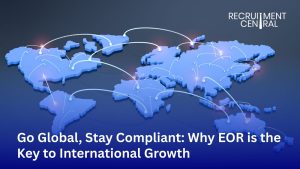It’s not only about Ganges, diverse festivals and colors, India holds more to this when it comes to skilled workforce. It’s quite evident from the recent report, which suggests that the rate of foreign companies hiring in India has increased massively in the last 3-4 years. Employers over the globe have been shifting their attention to India for hiring talent. Specifically, if I consider the case of Singapore, where employers have been suffering because of reduced work pass quota and restrictions.
To expand your workforce and legally hire employees in India, you as a company must complete obligations. Which starts from establishing a legal entity such as a Private Limited Company or LLP, and comply with a long list of labor laws which includes the Payment of Wages Act, the Employees’ State Insurance Act, the Maternity Benefit Act, the Industrial Employment (Standing Orders) Act, and the Trade Unions Act, ensuring proper compensation, maternity leave, along with being complete adherence to working conditions. This guide will help you know more about this and how you could efficiently hire employees in India.
Statutory Requirements
Yes, it all starts from understanding the statutory requirements, as these will be the determining factor for you to calculate cost and decide slabs.
Also Read: Guide to Choosing the Right Talent Management System
- Gratuity: As per the Payment of Gratuity Act, employees who successfully complete five years of continuous service will be eligible for the gratuity upon termination or retirement.
- Provident Fund (PF): It applies to both, the employer and the employee. They are required to contribute to the EPFO, a mandatory savings scheme. From which an employee could withdraw upon retirement or termination.
- Employee State Insurance (ESI): This only applies to specific categories of employees, ESI gives medical and cash benefits to the employees and their dependants.
- Professional Tax: Some states have also introduced a professional tax on employees, and the employer is solely responsible for deducting and rightly depositing this tax to the state labor department.
Taxes In India
Let’s consider the major factors of taxes and other mandatory social security programs in India;
Taxes in India
India has a comprehensive tax system which is significant from the norms that individuals with higher incomes will have to pay a higher percentage of their income. The income tax in India is governed by the Income Tax Act of 1961 and is administered by the Central Board of Direct Taxes (CBDT).
Below are the key components of the income tax system in India;
1. Income Slabs
- Individuals are classified into different income slabs, and each slab signifies a different tax rate.
- The slabs vary and depend upon the age of the employee (below 60 years, 60 to 80 years, and 80 years and above).
2. Tax Rates
The budget has been recently announced in India and the updates on salary tax slabs were implemented on February 1, 2025, the tax rates for individuals below 60 years are as follows;
Taxable Income (Rs.) Tax Rate (%)
0 – 12,00,000 Nil
12,00,001 – 16,00,000 15%
16,00,001 – 20,00,000 20%
20,00,001 – 24,00,000 25%
Above Rs 24 lakh 30%
3. Deductions and Exemptions
- Employees can also avail several deductions under sections such as 80C, 80D, 80G, etc., for investments, insurance premiums, donations, etc.
- Few exemptions are also allowed, like the House Rent Allowance (HRA) and Leave Travel Allowance (LTA).
4. Goods and Services Tax (GST)
- GST is another form of indirect tax that replaced several indirect taxes at the central and state levels.
- It is levied on the supply of goods and operation of services and has different classified slabs, including 5%, 12%, 18%, and 28%.
How To Legally Hire An Employee In India?
There are many options available, but understanding the feasibility and your requirements is essential. Below I have mentioned some of the highly preferred options on how could you legally hire an employee in India;
Hiring Via Your Own Legal Entity
It’s tough though to establish your branch or subsidiary in India, but it could help you to fill requirements and other HR tasks internally. To set up an entity in India, there are some strict regulations set by the Indian law which you must fulfill, understand below;
To build a subsidiary and hire in India, you must have to obtain;
- Director Identification Number (DIN)
- Digital Signature Certificate (DSC)
- Business name approved by the Registrar of Companies
- Memorandum and Articles of Association
- Incorporation application
- Certificate to commence operations
- Permanent Account Number (PAN)
- Employees’ Provident Fund Organization filing
- Goods and Services Tax (GST) registration, and
- Medical insurance application
In case of some special industry types like medical, there are some extra or special permits which you need to obtain.
Partnering With An Employer Of Record
The term became famous when some startups or small scale companies from foreign started to hire in India and came to know about the secret enterprises that have been following from the last many years to cut costs and acquire best talent. Employer of Record (EOR), also known as a professional employment organization (PEO) is simply a local entity based in India helping you acquire talent as per your needs but at 60-70% reduced cost. They have established networks and have complete compliance with legalities and other labor laws assuring you a complete set of services as required without any hassle you aren’t aware about.
Important Indian Labor Laws Characteristics
If you have been planning to establish your own legal entity in India, then you must consider below mentioned factors to ensure compliance;
| Indian Law or Practice | Description |
| 13th-month pay | Essentially equal to one-month’s pay. It applies to every employer. It is provided as a bonus, typically given at the end of the year |
| Paid time off | This is typically 10-15 days in India |
| Permanent establishment | As we’ve stated above, your company can do this itself or go through an EOR |
| Sick leave | Maximum of 12 days annually |
| Parental and maternity leave | Paternity leave is not mandatory. Maternity leave is maximum 26 weeks for the first two deliveries and 12 weeks for each delivery thereafter¹² |
| Holidays | 17 public holidays occur annually in India and working on these holidays requires additional pay¹³ |
| Taxes | Income tax, Provident Fund, Employee State Insurance, Goods and Services Tax, Professional Tax |
| Minimum wage | Labor costs vary by state and job type. The national minimum wage is $2.15.¹⁴ |
| Overtime | Overtime payments kick in when an individual works more the 9 hrs.¹⁵ |
| 65 – 70 | SGD 50 – SGD 500 |
| SGD 500 – SGD 750 | |
| SGD 750 & above | |
| Above 70 | SGD 50 – SGD 500 |
| SGD 500 – SGD 750 | |
| SGD 750 & above |
Conclusion
Establishing your own legal entity or GCC is old fashioned and I don;t believe that every scale of company could afford that. What I mean to imply here is that you must understand your feasibility and understand the available options in detail, as one option would suit one and could not be feasible for the other one at the same given time. Staying compliant to the local labor laws is a challenge which increases cost indirectly and impacts the whole budget. Leveraging EOR services suits as the best as they take care of everything while you operate your local entity in India with full control from anywhere over the globe.







